Learn About Maui
Learn About Maui
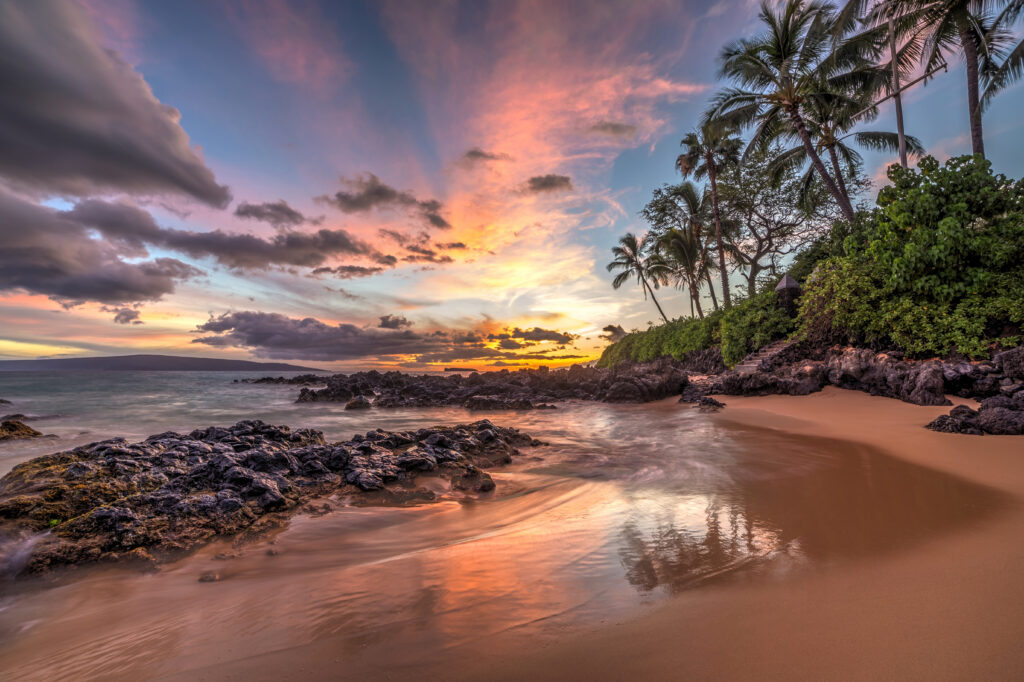
Colourful sunset from secret cove, Maui, Hawaii
The Island of Maui
Maui, often referred to as The Valley Isle, is a place of enchantment where natures artistry and cultural richness converge in a way that captivates the imagination. Nestled in the heart of the Pacific Ocean, Maui is the second-largest island in the Hawaiian archipelago, yet it exudes an intimate charm that invites exploration and discovery. With its dramatic volcanic landscapes, pristine beaches, and lush rainforests, Maui offers an unparalleled connection to the natural world. But beyond its physical beauty lies a profound cultural heritage and a deep sense of aloha that defines the islands spirit.
The story of Maui began millions of years ago with the volcanic activity that shaped its distinctive geography. The island is the result of two massive shield volcanoes, Haleakalā and the West Maui Mountains, whose lava flows merged to form a single landmass. This unique formation created the valleys and ridges that earned Maui its nickname, The Valley Isle. Today, Haleakalā stands as the islands crown jewel, its summit rising over 10,000 feet above sea level and offering views that seem to stretch to infinity. The dormant volcano is a place of spiritual significance and scientific wonder, home to endemic species and a terrain that feels otherworldly.
Mauis beauty has long inspired legends and traditions. According to Hawaiian mythology, the demigod Maui is said to have created the islands by lassoing the sun to slow its journey across the sky, giving his people longer days to fish and grow crops. This mythological figure lends his name to the island, imbuing it with a sense of magic and wonder. The connection between the land and the stories of its people is deeply woven into Mauis identity, a testament to the Hawaiian belief in the interconnectedness of all things.
The arrival of Polynesian voyagers over a thousand years ago marked the beginning of human habitation on Maui. These skilled navigators brought with them plants, animals, and cultural practices that laid the foundation for Hawaiian society. They established thriving communities, cultivating taro in irrigated fields and constructing intricate fishponds that demonstrated a profound understanding of sustainability. The concept of ahupuaa—land divisions that stretched from the mountains to the sea—governed their resource management, ensuring a harmonious relationship with the environment.
As centuries passed, Maui became a center of political and cultural significance. The island was the seat of power for King Piilani, a 16th-century ruler who unified the island and is remembered for his contributions to infrastructure and governance. The construction of the Piilani Trail, a network of pathways that connected communities across the island, symbolized the unity and ingenuity of his reign. Today, remnants of these ancient trails can still be found, offering a glimpse into the ingenuity of Mauis early inhabitants.
Mauis history took a dramatic turn with the arrival of Western explorers in the late 18th century. The island became a focal point for trade, particularly in sandalwood, which was highly valued in Asian markets. This era brought increased interaction between Hawaiians and the outside world, introducing new goods, ideas, and challenges. Missionaries arrived in the early 19th century, bringing Christianity, literacy, and Western education. While these influences led to significant changes in Hawaiian society, they also contributed to the erosion of traditional practices and beliefs.
The 19th century also marked the rise of plantation agriculture in Maui, with sugarcane and pineapple becoming dominant crops. Immigrant laborers from China, Japan, Portugal, the Philippines, and other countries arrived to work on the plantations, creating a multicultural community that remains a defining feature of Maui today. The plantation era transformed the islands economy and landscape, and its legacy can still be seen in the architecture and cultural traditions of towns like Lahaina and Wailuku.
Lahaina, once the capital of the Hawaiian Kingdom, holds a special place in Mauis history. This picturesque seaside town was a bustling hub for the whaling industry in the 19th century, attracting sailors from around the world. Its streets are lined with historic buildings, including the Lahaina Courthouse and the Baldwin Home, which stand as reminders of the towns storied past. The massive banyan tree in the center of town, planted in 1873, is a living testament to the passage of time and the communitys resilience.
The natural beauty of Maui has always been its greatest asset, drawing visitors long before the advent of modern tourism. The islandsdiverse ecosystems range from the arid landscapes of the south to the lush rainforests of the east, each offering its own unique experiences. The Hana Highway, a winding road that hugs the islands northeastern coastline, is a journey through paradise. Waterfalls cascade into emerald pools, black sand beaches glisten under the sun, and bamboo forests whisper ancient secrets to those who venture along this iconic route.
Haleakalā National Park is another jewel in Mauis crown. Visitors flock to its summit to witness sunrise, an ethereal experience that has been likened to standing on the edge of the world. The park also encompasses the Kīpahulu District, home to the Pools of Oheo and the Pīpīwai Trail, which meanders through a towering bamboo forest to the majestic Waimoku Falls. These natural wonders serve as a reminder of the islands power and fragility, inspiring efforts to preserve its beauty for future generations.
Mauis beaches are legendary, each with its own character and allure. Kāanapali Beach, with its golden sands and clear waters, was once a retreat for Hawaiian royalty and is now a haven for sunseekers and snorkelers. Makena Beach, often called Big Beach, offers a more secluded experience, with its expansive shoreline framed by rugged cliffs. On the islands north shore, Hookipa Beach is a mecca for windsurfers and kiteboarders, and its waves provide a playground for adrenaline seekers.
The waters surrounding Maui are teeming with life, from vibrant coral reefs to majestic humpback whales. Every winter, these gentle giants migrate to the warm waters of Maui Nui to breed and give birth, creating one of natures most awe-inspiring spectacles. Whale-watching tours offer a chance to witness these magnificent creatures up close, while snorkeling and diving excursions reveal the kaleidoscope of marine life that thrives beneath the waves.
Mauis cultural richness is as compelling as its natural beauty. The island is a living canvas where traditions are honored and innovation is embraced. Festivals like the Maui Film Festival and the East Maui Taro Festival celebrate the islands creative spirit and agricultural heritage. Hula, the ancient art of storytelling through dance, is performed with reverence and passion, connecting participants to their ancestors and the land. Local artisans craft everything from lauhala mats to intricate featherwork, preserving techniques passed down through generations.
The people of Maui are the heartbeat of the island, their stories interwoven with its history and landscapes. Native Hawaiians continue to practice the customs and values that have sustained their culture for centuries, from mālama āina (caring for the land) to aloha ohana (love for family). Their resilience and adaptability are mirrored in the multicultural communities that call Maui home, where diverse traditions coexist harmoniously, enriching the islands identity.
Maui is also a place of renewal and discovery. Its healing energy has drawn seekers from around the world, offering solace and inspiration. Whether exploring the rugged trails of the West Maui Mountains, savoring the flavors of farm-to-table cuisine, or simply watching the sun dip below the horizon, visitors find themselves embraced by the islandsmana or spiritual power. This connection to something greater is what sets Maui apart, leaving an indelible mark on all who are fortunate enough to experience its magic.
As the sun rises over Haleakalā and sets along the shores of Kāanapali, Maui continues to weave its timeless story, inviting all who visit to become part of its narrative. The Valley Isle is more than a destination; it is a place where life unfolds in its purest, most beautiful form, leaving hearts forever touched by its grace and wonder.
History of the Island of Maui
The island of Maui, often referred to as "The Valley Isle," is a place where the past and present coexist in harmony. Its lush valleys, towering volcanic peaks, and pristine coastlines are imbued with stories of ancient Polynesian voyagers, legendary Hawaiian monarchs, and transformative encounters with the outside world. Maui's history is a fascinating tapestry of cultural evolution, environmental adaptation, and human resilience that has shaped the island into the vibrant destination it is today.
Formation and Early Geology
Maui's history began millions of years ago, long before the arrival of humans. The island was formed by volcanic activity, primarily the eruptions of two massive shield volcanoes, Haleakalā and the West Maui Mountains, or Mauna Kahalawai. These volcanoes eventually merged, creating the distinctive landmass that characterizes Maui today. Haleakalā, the younger and larger of the two, dominates the island with its towering summit, which rises over 10,000 feet above sea level. The volcanic landscapes, combined with millennia of erosion, have given Maui its diverse topography, ranging from arid lowlands to lush rainforests and fertile valleys.
The merging of the volcanic flows also created Maui's central isthmus, a flat expanse of land that connects the two mountain ranges. This unique geography earned Maui its nickname, "The Valley Isle," as the isthmus is flanked by the towering ridges of Haleakalā and Mauna Kahalawai. Over time, these volcanic formations became home to a variety of ecosystems, supporting a rich diversity of plant and animal life that continues to thrive to
Polynesian Settlement
Maui's human history began over 1,500 years ago when Polynesian voyagers arrived in Hawaii. These skilled navigators, guided by the stars, ocean currents, and natural phenomena, brought with them the plants, animals, and cultural traditions that would lay the foundation for Hawaiian society. Maui, with its fertile valleys and abundant natural resources, became an ideal place for settlement.
The Polynesians established complex and self-sustaining communities on Maui. They cultivated taro in irrigated fields called lo'i, constructed intricate loko i'a (fishponds) to raise fish, and relied on the land's natural resources to support their growing population. The island was divided into ahupua'a, wedge-shaped land divisions that extended from the mountains to the sea. Each ahupua'a provided access to a variety of resources, ensuring the sustainability of the community.
Hawaiian society on Maui was hierarchical, led by ali'i (chiefs) who ruled over the ahupua'a. The chiefs were supported by priests (kahuna), farmers, fishermen, and other community members. Spirituality played a central role in daily life, with ceremonies and rituals conducted to honor the gods and maintain harmony with nature. Temples, or heiau, were constructed across the island as places of worship and offerings.
The Reign of King Pi'ilani
One of the most significant figures in Maui's early history is King Pi'ilani, who ruled the island in the 16th century. Pi'ilani is remembered as a unifier and a visionary leader who brought stability and prosperity to Maui. His reign marked a golden age for the island, with advancements in governance, infrastructure, and cultural development.
Pi'ilani's legacy includes the construction of the Pi'ilaniTrail, an extensive network of pathways that connected different regions of Maui. This trail facilitated trade and communication between communities, fostering a sense of unity among the island'sinhabitants. The Pi'ilani Trail is considered one of the most impressive engineering feats of ancient Hawaii, and portions of it can still be traced today.
Pi'ilani's family continued his legacy, with his son, Kiha-a-Pi'ilani, expanding the island's influence and maintaining peace. The era of Pi'ilani's reign is often regarded as a time of cultural flourishing, as Maui became known for its skilled craftsmen, storytellers, and hula practitioners.
Contact with the Western World
The arrival of Western explorers in the late 18th century marked a turning point in Maui's history. Captain James Cook, the first European to visit the Hawaiian Islands in 1778, opened the door for increased interaction between Hawaiians and the outside world. In the years that followed, Maui became a hub for trade, particularly in sandalwood, which was highly valued in Chinese markets.
This era of contact brought both opportunities and challenges. While trade introduced new goods and technologies, it also disrupted traditional Hawaiian practices and introduced diseases that devastated the native population. The Hawaiian population declined dramatically during this period, altering the social and cultural fabric of the islands.
The Missionary Era
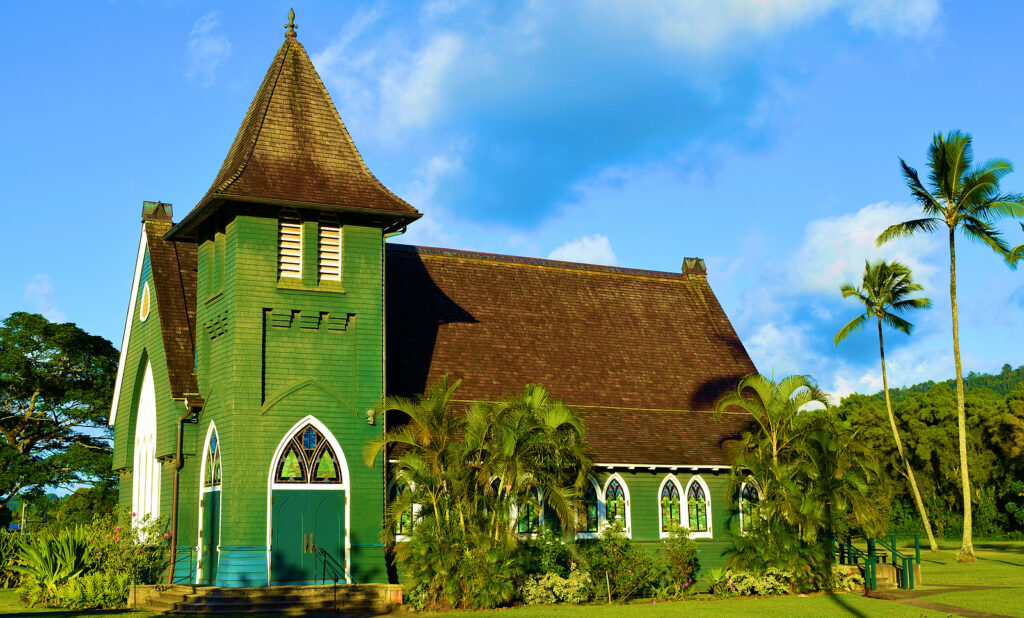
Waioli Huila Mission Church which was built by missionaries in 1843 surrounded by lush green manicured gardens taken at Hanalei Bay in Kauai, HI
In the early 19th century, Christian missionaries arrived in Hawaii, including Maui, with the goal of converting the native population to Christianity. Their influence was profound, leading to significant changes in Hawaiian society. The missionaries introduced a written Hawaiian language, established schools, and spread literacy among the population. By the mid-19th century, Hawaii had one of the highest literacy rates in the world.
However, the missionary presence also contributed to the erosion of traditional Hawaiian beliefs and practices. Cultural expressions such as hula and certain religious rituals were discouraged or banned as they were deemed inconsistent with Christian values. Despite these challenges, the introduction of Western education and infrastructure helped lay the groundwork for Maui's modernization.
The Plantation Era
The 19th century saw the rise of plantation agriculture on Maui, with sugarcane and pineapple becoming dominant crops. The fertile lands of Maui's central valley were ideal for large-scale farming, and the plantation industry became the backbone of the island's economy.
To meet the labor demands of the plantations, immigrant workers were brought to Maui from China, Japan, Portugal, the Philippines, and other countries. This influx of diverse cultures transformed Maui's social landscape, creating a multicultural community that remains a defining feature of the island today.
The plantation era also spurred infrastructure development, including the construction of railroads, irrigation systems, and ports. Towns such as Lahaina and Wailuku grew as economic and cultural centers, reflecting the island's evolving identity.
The Plantation Era/Lahaina: From Capital to Cultural Hub
Lahaina, located on Maui{'}s western coast, played a pivotal role in the island{'}s history. Once the capital of the Hawaiian Kingdom, Lahaina was a bustling center of governance and trade. In the 19th century, it became a major hub for the global whaling industry, attracting sailors from around the world.
The town{'}s historic sites, including the Lahaina Courthouse and the Baldwin Home, offer glimpses into its storied past. The iconic banyan tree in the heart of Lahaina, planted in 1873, stands as a living testament to the passage of time and the resilience of the community.
The Overthrow of the Hawaiian Monarchy

Iolani Palace in Honolulu, Hawaii. The only royal palace in the United States.
The late 19th century was a period of political upheaval for Hawaii, culminating in the overthrow of the Hawaiian monarchy in 1893. Queen Lili{'}uokalani, the last reigning monarch, was deposed by a group of American and European businessmen with the support of U.S. military forces. This event led to the annexation of Hawaii by the United States in 1898, marking the end of the Hawaiian Kingdom.
Maui, like the other islands, experienced significant changes during this period. The transition from a sovereign kingdom to a U.S. territory brought new opportunities for economic growth but also deepened the cultural and political challenges faced by Native Hawaiians.
Modern Maui
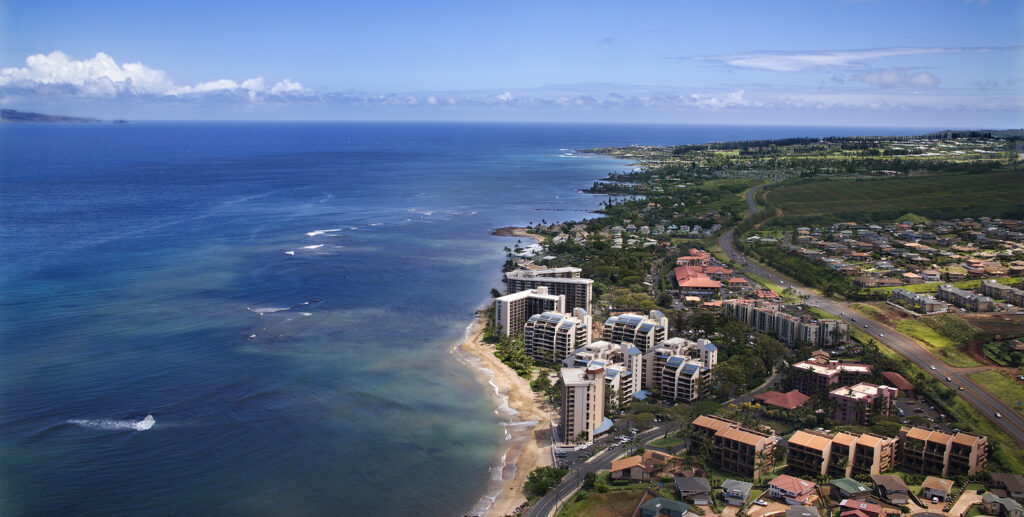
Aerial view of buildings on coastline of Maui Hawaii.
The 20th century ushered in a new era for Maui, characterized by diversification and growth. The decline of the plantation industry in the mid-20th century led to a shift toward tourism as the island{'}s primary economic driver. Maui{'}s natural beauty, including its pristine beaches, lush rainforests, and dramatic volcanic landscapes, made it a premier destination for travelers from around the world.
Haleakalā National Park, established in 1916, became a focal point for conservation and tourism. The park{'}s summit, known as the "House of the Sun," offers breathtaking views and a connection to the island{'}s cultural and spiritual heritage.
Today, Maui continues to balance its rich history with the demands of modern life. Efforts to preserve Hawaiian traditions, protect the environment, and promote sustainable tourism reflect the island{'}s commitment to honoring its past while looking toward the future. From its volcanic origins to its vibrant multicultural communities, Maui{'}s history is a testament to the resilience and adaptability of its people.
Famous People from the Island of Maui
Maui, the picturesque "Valley Isle," is known for its breathtaking landscapes, vibrant culture, and deep history. Over the centuries, this island has been home to a remarkable array of individuals who have left indelible marks on Hawaii and the wider world. From ancient monarchs who unified kingdoms to modern artists and innovators, the famous people of Maui reflect the island's unique spirit of creativity, resilience, and aloha.
King Pi'ilani
King Pi'ilani, one of Maui's most renowned rulers, played a pivotal role in shaping the island's history. Born in the 16th century, Pi'ilani unified Maui under his rule and is remembered for his remarkable contributions to governance and infrastructure. His reign brought peace and prosperity to the island, establishing a legacy of stability and innovation.
One of Pi'ilani's greatest achievements was the construction of the Pi'ilani Trail, an extensive network of pathways that connected communities across Maui. This trail facilitated trade and communication, fostering a sense of unity among the island's inhabitants. Portions of the Pi'ilani Trail remain intact today, serving as a testament to his vision and leadership. King Pi'ilani's legacy continues to be celebrated in Maui's cultural narratives, reminding residents and visitors alike of the island's rich heritage.
Queen Ka'ahumanu
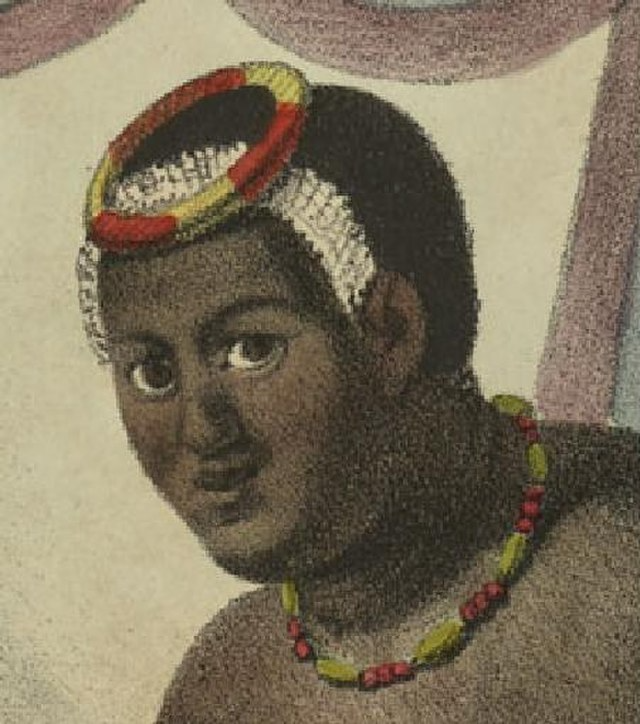
The queen of old Hawaii Queen Ka{`'`}ahumanu. 1768-1832
Born on Maui in 1768, Queen Ka'ahumanu was one of the most influential figures in Hawaiian history. She became the favorite wife of King Kamehameha I, playing a critical role in his unification of the Hawaiian Islands. After Kamehameha's death, Ka'ahumanu served as Kuhina Nui, a position akin to a co-regent, wielding significant political power.
Ka'ahumanu was a transformative leader who brought sweeping changes to Hawaiian society. She embraced Christianity and played a key role in its spread throughout the islands. She also challenged the traditional kapu system, a set of religious and social laws, advocating for its abolition. Her progressive leadership reshaped Hawaiian governance and culture, leaving a profound impact on Maui and the entire archipelago.
Charles Lindbergh

Graduation photo of 2nd Lt. Charles A. Lindbergh, USASRC, March, 1925
Lindbergh's final resting place is at the Palapala Ho'omau Church in Hana, a quiet, unassuming spot that reflects his love for simplicity. Visitors to this site often pay homage to the pioneering aviator who found peace and inspiration on Maui's shores.
Lindbergh's final resting place is at the Palapala Ho'omau Church in Hana, a quiet, unassuming spot that reflects his love for simplicity. Visitors to this site often pay homage to the pioneering aviator who found peace and inspiration on Maui's shores.
Keali'i Reichel
Keali'i Reichel, a celebrated Hawaiian musician, singer, and kumu hula (hula teacher), was born and raised in Maui. Renowned for his hauntingly beautiful voice and commitment to preserving Hawaiian culture, Reichel has become one of the most influential figures in contemporary Hawaiian music. His albums, including Kawaipunahele and E O Mai, have garnered numerous awards and brought Hawaiian language and traditions to global audiences.
In addition to his music, Reichel founded Halau Ke'alaokamaile, a hula school dedicated to perpetuating the art of hula and Hawaiian cultural practices. Through his work, Keali'i Reichel has become a cultural ambassador, sharing the stories and spirit of Maui with the world.
Shane Victorino
Shane Victorino, affectionately known as the "Flyin' Hawaiian," is a professional baseball player who hails from Maui. Born in Wailuku in 1980, Victorino achieved great success in Major League Baseball, earning two World Series championships and multiple Gold Glove awards during his career.
Victorino's athleticism and dedication made him a standout player, and he remains a source of pride for Maui residents. Off the field, he is known for his philanthropic efforts, including supporting youth sports programs and initiatives to give back to his Hawaiian community.
Charles Lindbergh

Graduation photo of 2nd Lt. Charles A. Lindbergh, USASRC, March, 1925
Lindbergh's final resting place is at the Palapala Ho'omau Church in Hana, a quiet, unassuming spot that reflects his love for simplicity. Visitors to this site often pay homage to the pioneering aviator who found peace and inspiration on Maui's shores.
Lindbergh's final resting place is at the Palapala Ho'omau Church in Hana, a quiet, unassuming spot that reflects his love for simplicity. Visitors to this site often pay homage to the pioneering aviator who found peace and inspiration on Maui's shores.
Keali'i Reichel
Keali'i Reichel, a celebrated Hawaiian musician, singer, and kumu hula (hula teacher), was born and raised in Maui. Renowned for his hauntingly beautiful voice and commitment to preserving Hawaiian culture, Reichel has become one of the most influential figures in contemporary Hawaiian music. His albums, including Kawaipunahele and E O Mai, have garnered numerous awards and brought Hawaiian language and traditions to global audiences.
In addition to his music, Reichel founded Halau Ke'alaokamaile, a hula school dedicated to perpetuating the art of hula and Hawaiian cultural practices. Through his work, Keali'i Reichel has become a cultural ambassador, sharing the stories and spirit of Maui with the world.
Shane Victorino
Shane Victorino, affectionately known as the "Flyin' Hawaiian," is a professional baseball player who hails from Maui. Born in Wailuku in 1980, Victorino achieved great success in Major League Baseball, earning two World Series championships and multiple Gold Glove awards during his career.
Victorino's athleticism and dedication made him a standout player, and he remains a source of pride for Maui residents. Off the field, he is known for his philanthropic efforts, including supporting youth sports programs and initiatives to give back to his Hawaiian community.
Lahaina Artists and Storytellers
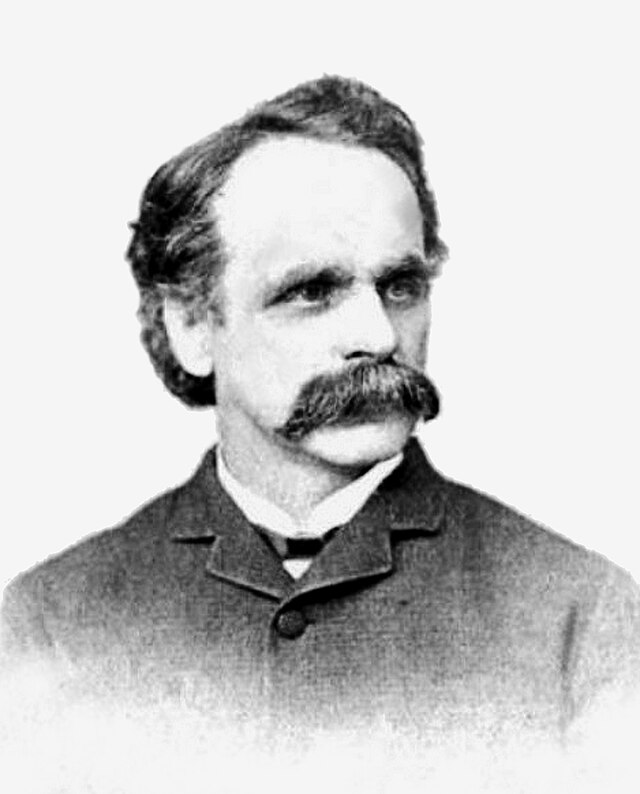
Edwin Dickens. Image from Sunset publication. Volumn IV November 1899 to April 1900. Southern Pacific Company
The historic town of Lahaina has long been a haven for artists, writers, and storytellers who draw inspiration from Maui's natural beauty and cultural richness. Figures such as Edwin Deakin and Georgia O'Keeffe spent time in Lahaina, capturing its charm through their art. While not native to Maui, their works have immortalized the island's landscapes and spirit, ensuring that its stories are shared with audiences far and wide.
Cultural Practitioners and Guardians of Tradition
Maui is home to countless cultural practitioners who dedicate their lives to preserving Hawaiian traditions. From kumu hula who perpetuate the sacred art of hula to navigators who sail Polynesian voyaging canoes like the Hōkūle'a, these individuals embody the spirit of aloha and the resilience of Hawaiian culture. Their contributions, though often unsung, are vital to maintaining Maui's identity and passing its heritage to future generations.
Famous Landmarks and Beaches on the Island of Maui
Maui, affectionately known as "The Valley Isle," is a treasure trove of breathtaking landmarks and world-renowned beaches. Its natural beauty and cultural heritage are woven into the island's landscape, offering visitors an immersive experience of paradise. From towering volcanic craters to serene stretches of sand, Maui's landmarks and beaches embody the spirit of aloha and provide endless opportunities for exploration and relaxation.
Haleakalā National Park
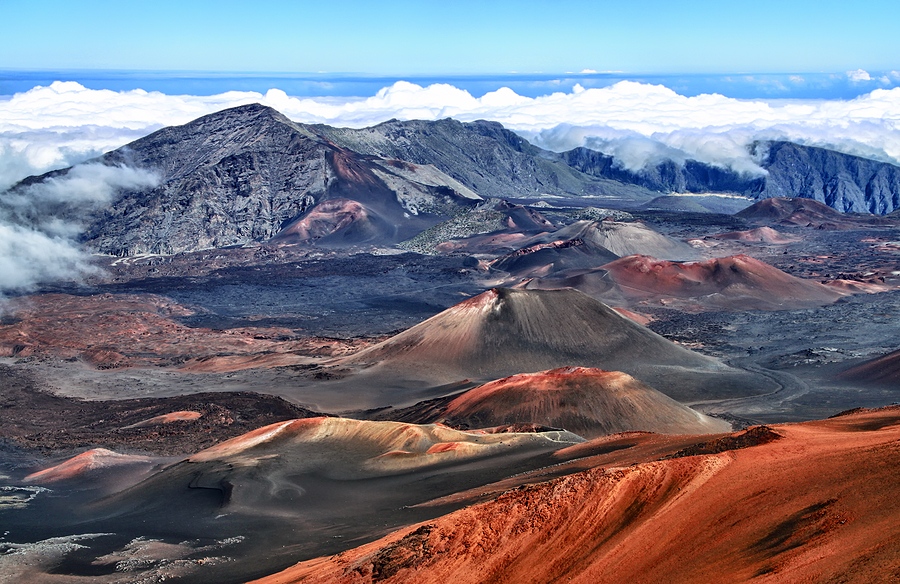
Caldera of the Haleakala volcano Maui, Hawaii
Haleakalā, often referred to as the "House of the Sun," is Maui's most iconic landmark. Rising over 10,000 feet above sea level, the dormant volcano dominates the island's landscape and offers some of the most awe-inspiring views in Hawaii. Haleakalā National Park encompasses this vast crater and its surrounding ecosystems, which range from barren volcanic terrain to lush tropical rainforests.
The sunrise at Haleakalā is a bucket-list experience, drawing visitors who wake before dawn to witness the sun emerging above a sea of clouds. The park also offers extensive hiking trails, such as the Sliding Sands Trail, which descends into the crater's otherworldly landscape. The Kīpahulu District, located on the island's eastern coast, is home to the Pools of 'Ohe'o and the Pīpīwai Trail, which leads through a towering bamboo forest to the majestic Waimoku Falls.
Road to Hana
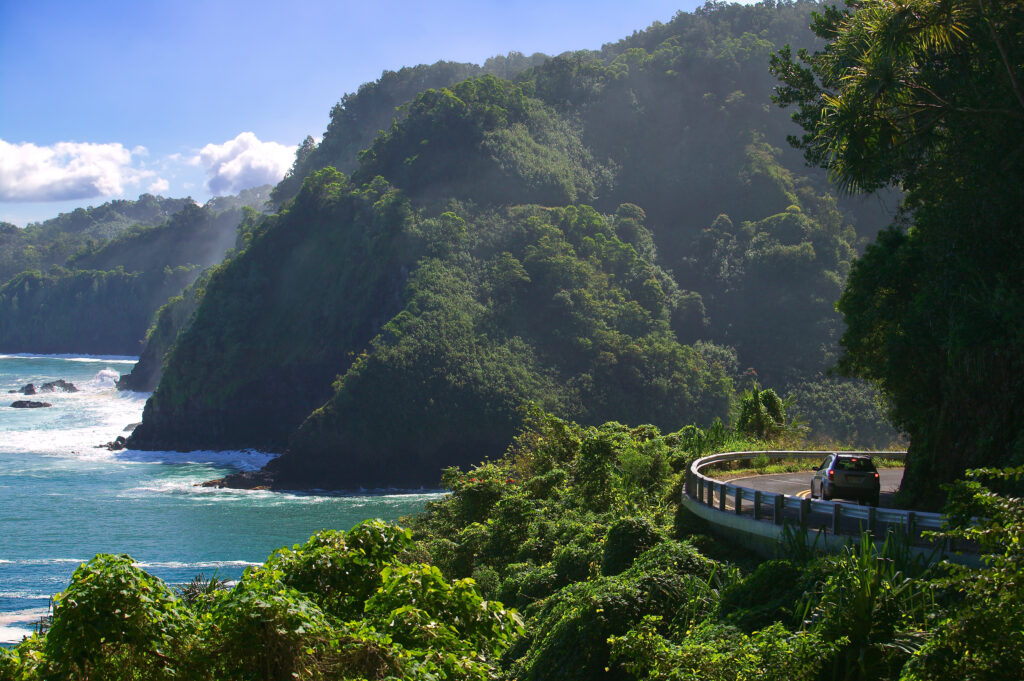
Road To Hana - Maui Hawaii. This winding road travels through one of the truly last undeveloped tropical areas of the island.
The Road to Hana is more than just a scenic drive; it is an adventure that showcases Maui's natural wonders. This winding highway spans 64 miles along the island's northeastern coast, passing through rainforests, waterfalls, and dramatic cliffs. Along the way, travelers encounter countless points of interest, including the Garden of Eden Arboretum, Wai'anapanapa State Park, and the Ke'anae Peninsula.
Each stop along the Road to Hana offers a unique glimpse into Maui's diverse landscapes. Wai'anapanapa State Park, with its black sand beach and freshwater caves, is a highlight of the journey. The drive culminates in the quaint town of Hana, where time seems to slow down, allowing visitors to savor the tranquility of this remote paradise.
Iao Valley State Monument
Nestled in the West Maui Mountains, Iao Valley is a sacred site rich in history and natural beauty. The Iao Needle, a striking 1,200-foot rock formation, rises dramatically from the valley floor and serves as a focal point for the area. This verdant valley was the site of the Battle of Kepaniwai in 1790, where King Kamehameha I defeated Maui's forces in his quest to unify the Hawaiian Islands.
Today, Iao Valley State Monument is a place of reflection and exploration. Visitors can wander along well-maintained trails, marvel at the lush vegetation, and learn about the valley's cultural significance through interpretive exhibits.
Lahaina Historic District
Once the capital of the Hawaiian Kingdom and a bustling whaling port, Lahaina is steeped in history and charm. The Lahaina Historic District preserves the town's rich heritage, with landmarks such as the Lahaina Courthouse, the Baldwin Home Museum, and the iconic banyan tree that shades the town square. Planted in 1873, this massive tree has grown to span an entire city block, making it one of the largest banyan trees in the United States.
Lahaina's vibrant art galleries, shops, and restaurants add to its appeal, blending history with modern attractions. The town's picturesque harbor serves as a gateway for whale-watching tours and other ocean adventures.
Molokini Crater
Located just off Maui's southwestern coast, Molokini Crater is a crescent-shaped volcanic atoll renowned for its pristine waters and vibrant marine life. This underwater sanctuary is a popular destination for snorkeling and scuba diving, offering visibility of up to 150 feet. The protected reef is home to over 250 species of fish, as well as sea turtles and colorful coral formations.
Accessible only by boat, Molokini Crater provides an unforgettable experience for those seeking to explore Maui's underwater treasures. Its unique shape and geological history make it a fascinating landmark both above and below the surface.
Kā'anapali Beach
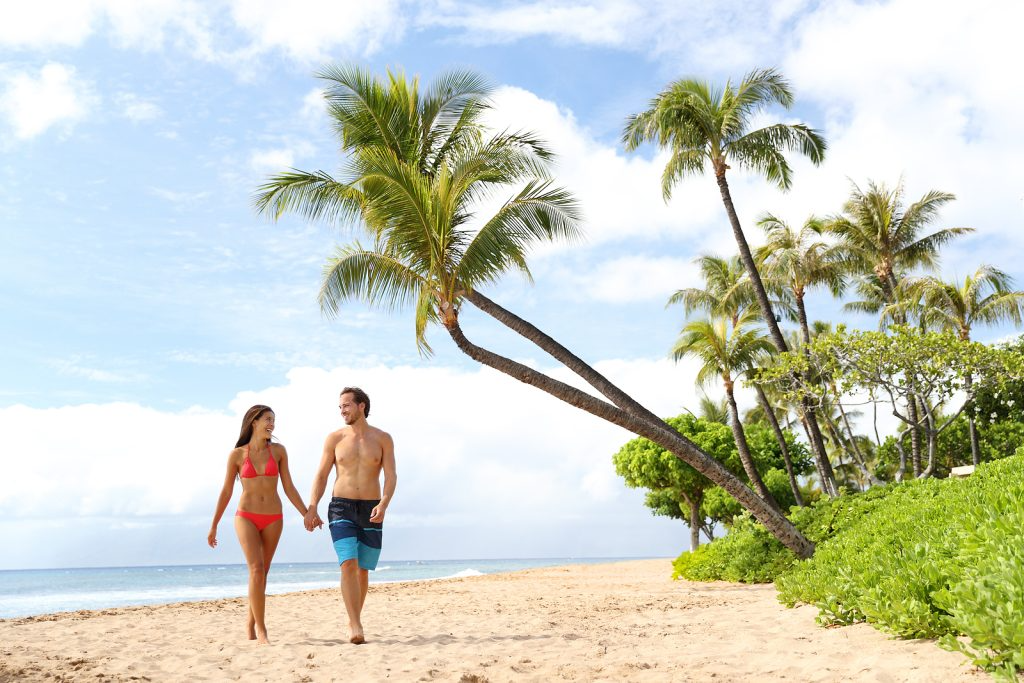
Golden sands and turquoise waters at Kaanapali Beach, Maui—where luxury meets the breathtaking beauty of one of Hawaii{`'`}s most famous beaches.
Kā'anapali Beach, located on Maui's western shore, is a three-mile stretch of golden sand that epitomizes tropical paradise. Once a retreat for Hawaiian royalty, this beach is now a hub of activity, offering everything from sunbathing and swimming to snorkeling and paddleboarding.
The beach is anchored by Black Rock (Pu'u Keka'a), a sacred site where ancient Hawaiians believed souls leaped into the afterlife. Today, it is a popular snorkeling spot teeming with marine life. Kā'anapali Beach is also home to luxury resorts, open-air shopping, and nightly cliff diving ceremonies, which celebrate Hawaiian tradition.
Makena Beach (Big Beach)

Golden sands and turquoise waters at Makena Beach, Maui—one of Hawaii{`'`}s most beautiful and expansive beaches, perfect for relaxation and adventure.
Makena Beach, often referred to as Big Beach, is one of Maui's largest and most unspoiled beaches. Located in South Maui, this expansive shoreline is framed by rugged cliffs and offers stunning views of Molokini Crater and Kaho'olawe Island.
Big Beach's crystal-clear waters and soft, golden sand make it a favorite among locals and visitors. While the waves can be powerful, the beach's natural beauty and serene atmosphere provide an ideal setting for relaxation and exploration.
Ho'okipa Beach
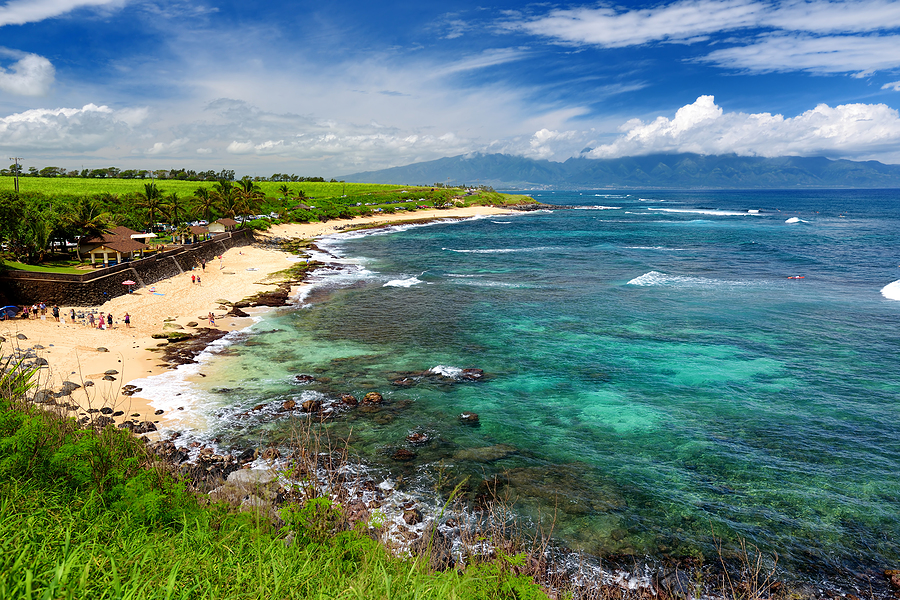
Majestic waves and basking sea turtles at Hookipa Beach, Maui—a world-famous destination for surfers and one of Hawaii{`'`}s most beautiful beaches.
Situated on Maui's north shore, Ho'okipa Beach is a world-renowned destination for windsurfing and kiteboarding. Its consistent trade winds and challenging waves attract professional athletes and spectators from around the globe. During the winter months, the beach's surf swells make it a prime spot for watching skilled surfers tackle massive waves.
Ho'okipa Beach is also an excellent place to observe Hawaiian green sea turtles (honu), which often rest on the sand near the western end of the beach. The scenic overlooks along the Hana Highway provide breathtaking views of this dynamic coast.
Wailea Beach
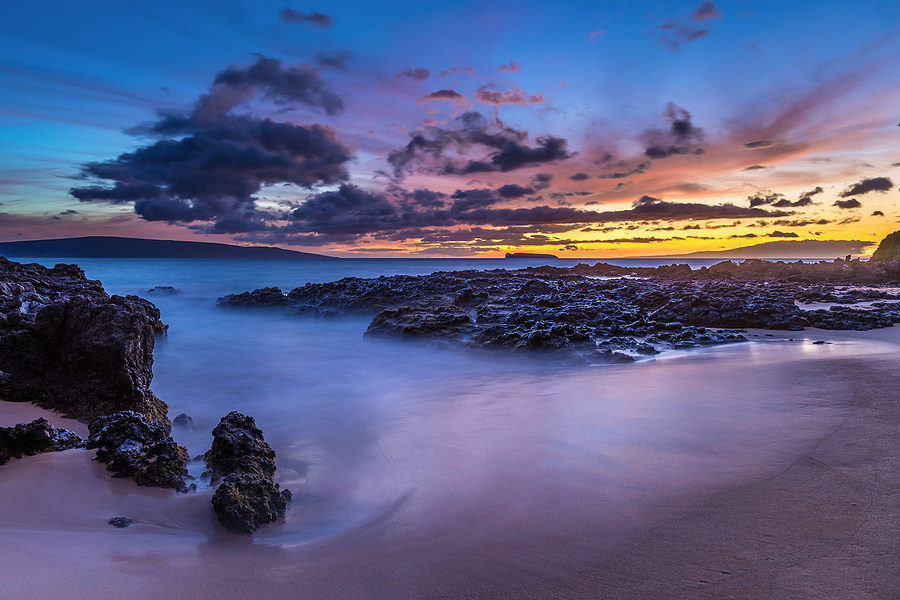
Golden hues paint the sky at Secret Cove, Maui—where the serenity of sunset meets the timeless beauty of one of Hawaii{`'`}s hidden treasures.
Wailea Beach, located in South Maui, is synonymous with luxury and tranquility. This crescent-shaped beach is flanked by some of Maui's most exclusive resorts, offering world-class amenities and impeccable views. The calm waters and gentle waves make Wailea Beach ideal for swimming, snorkeling, and paddleboarding.
The nearby Wailea Beach Path provides a scenic route for walking or jogging, connecting visitors to other beautiful beaches and lush landscapes in the area. Wailea Beach's blend of natural beauty and sophistication makes it a premier destination on Maui.
Wai'anapanapa State Park
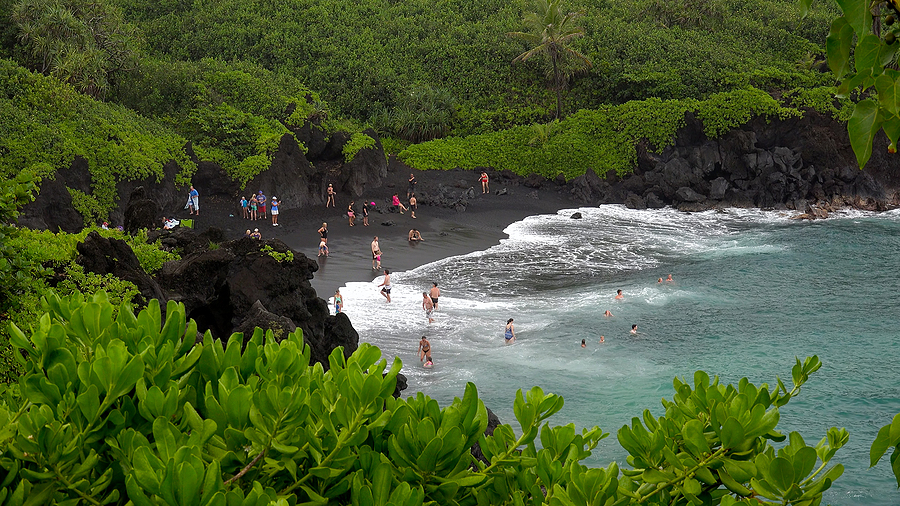
A breathtaking view of Waianapanapa Beach, Maui, where dramatic black sands meet turquoise waters, creating one of Hawaii{`'`}s most stunning and unique coastal landscapes.
Wai'anapanapa State Park, located near Hana, is home to one of Maui's most striking beaches: a black sand shoreline formed by volcanic activity. The contrast of the dark sand with the turquoise waters creates a dramatic and unforgettable setting.
The park also features sea caves, blowholes, and tide pools, offering a variety of activities for adventurous visitors. Hiking trails wind through the area, providing panoramic views of the rugged coastline and opportunities to learn about its cultural significance.
Napili Bay
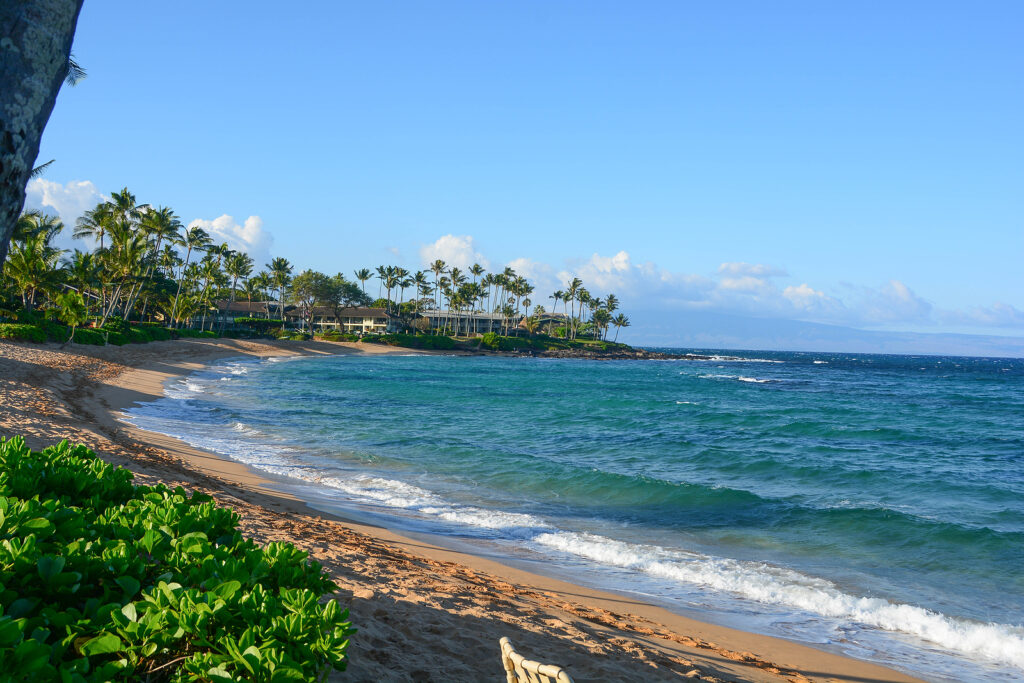
Shore in Napili Bay, Maui
Napili Bay, a serene crescent of golden sand on Maui's northwestern coast, is a favorite spot for families and couples seeking a tranquil escape. The bay's calm, shallow waters are perfect for swimming and snorkeling, while its idyllic setting offers stunning sunset views.
Napili Bay's charm lies in its laid-back atmosphere and natural beauty. The absence of large resorts preserves its intimate feel, making it a hidden gem among Maui's many beaches.
Maui's landmarks and beaches are a testament to the island's unparalleled beauty and cultural significance. Each site tells a story, offering visitors a chance to connect with the land and experience the magic of The Valley Isle.